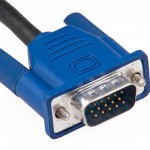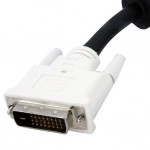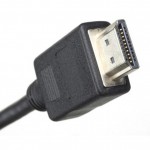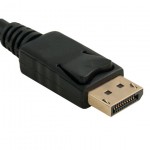[sg_popup id=”1″ event=”onload”][/sg_popup]Most motherboards and discrete video cards these days come with a variety of video outs, allowing you to connect to just about any display still available. But what’s the difference in these connections? Given the option, what’s the best way to connect your PC to your display? Read on to learn more about HDMI vs DisplayPort vs DVI vs VGA.

VGA (aka D-Sub)
We’ll start with the oldest of the group. VGA (Video Graphics Array) is an analog video connection identifiable by its blue port and 15-pin connector that was originally introduced in 1987. Because it maxes out at a 640×480 resolution in standard modes, it’s rare to see an LCD monitor with this input option, though some lower end GPUs and entry level motherboards do still offer it. Frankly though, if you’re still connecting via VGA, you’re long overdue for a display upgrade. Time to bite the bullet.
Pros – connects to CRT monitors without an adapter
Cons – Analog connection and lower resolution output means much less picture clarity and fewer colors; Essentially obsolete; Does not carry audio

DVI
DVI (Digital Video Interface) is essentially the digital replacement to VGA and has totally dominated the PC monitor connection arena for nearly 15 years. Known by its white plug, DVI comes in two common flavors – DVI-D, which is digital only, and DVI-I, which carries both the analog and digital signal. This means if you intend to connect a DVI to VGA adapter to a DVI port, make sure that port is DVI-I. Despite being a little long in the tooth, DVI is still universally available on all desktops and virtually all standard HD monitors.
Pros – Fairly ubiquitous across virtually all PCs and HD monitors; Dual link DVI (what ships today) is capable of resolutions up to 2560 x 1600 at 60Hz
Cons – Does not support 4K; Does not carry audio

HDMI
HDMI (High Definition Multimedia Interface) is the digital standard for connecting virtually all peripherals – Blu ray players, gaming consoles, cable boxes, and home theater PCs – to standard 1080p TVs as well as many newer desktops and laptops. There have been six versions of HDMI since its inception, so be sure the version you have is capable of handling the resolutions of your display at your desired refresh rate. The most common is HDMI 1.4 which can do 2560×1600 @ 60Hz, 4096×2160 @ 30Hz, and 1920 x 1080 3D @ 24 Hz.
Pros – carries audio and video streams in one cable; Backwards compatible with DVI
Cons – Can only handle a single video stream for one independent display per port; Need HDMI 2.0 port and cable for 4K resolutions at 60 Hz

DisplayPort
DisplayPort is the newest of these display standards and visually very similar to HDMI with much of the same functionality. It’s capable of handling multiple video and audio streams and display resolutions up to 7680×4320 @ 60Hz. DisplayPort is available on all 4K monitors and many newer 1080p models so if you’re looking to future proof your video connection, DisplayPort is the way to go.
Pros – capable of up to 8K resolutions at 60Hz refresh; Support for Multi-Stream Transport, meaning connection of up to 3 independent displays per port via MST hub.
Cons – No Consumer Electronics Control commands which allows for the control of multiple devices (like a Blu ray connected to an HDTV with a single remote)
Josh Covington
Latest posts by Josh Covington (see all)
- RTX 6000 Pro Blackwell - July 1, 2025
- What is CUDIMM? - January 29, 2025
- X870 vs B850: Choosing the Right Motherboard for Your Build - January 17, 2025